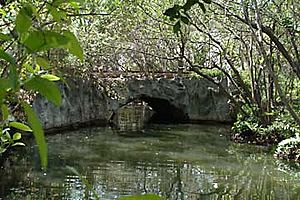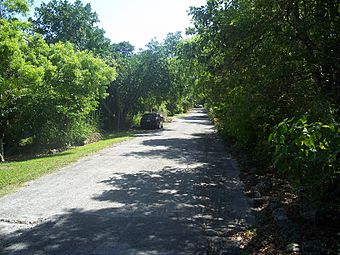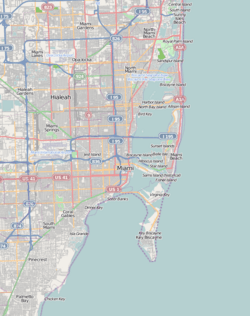Arch Creek, Florida facts for kids
Quick facts for kids Arch Creek Park |
|
|---|---|

Arch Creek natural limestone bridge was the site of an early settlement in Miami-Dade County
|
|
| Type | Municipal |
| Location | Miami, Miami-Dade County, Florida, United States |
| Area | 9.4 acres (38,000 m2) |
| Created | 1982 |
| Operated by | Miami-Dade County Parks and Recreation Department |
| Website | [1] |
|
Arch Creek Historic and Archeological Site
|
|
 |
|
| Location | Miami, Miami-Dade County, Florida, USA |
| Nearest city | North Miami, Florida |
| NRHP reference No. | 86001700 |
| Added to NRHP | July 15, 1986 |
Arch Creek is a special place in Miami-Dade County, Florida. It was once an early settlement and is now part of the Arch Creek Memorial Park. Long ago, the Tequesta Indians lived here before Europeans arrived in the 1500s.
The area gets its name from a natural limestone bridge that used to stretch 40 feet (12 meters) over the creek. This amazing bridge collapsed in 1973. Today, Arch Creek Memorial Park is located at 1855 Northeast 135th Street, right on Biscayne Boulevard. It was added to the U.S. National Register of Historic Places on July 15, 1986, because of its important history.
Contents
Exploring Arch Creek's Past
Who Lived Here First?
For many centuries before Europeans came, different groups of native people lived in the Arch Creek area. The Tequesta people were among them. They thrived in this region, using the natural resources around the creek.
Trails, Trains, and New Settlers
During the Seminole Wars, a military trail was created between Fort Lauderdale and Fort Dallas. This trail crossed over the natural limestone bridge at Arch Creek. The creek itself brought fresh water from the Everglades to Biscayne Bay.
In 1895, the railroad built by Henry Flagler reached Arch Creek. This brought many new visitors and settlers, mostly from states along the east coast.
Life in the Early Settlement
The first European-American families who settled here started farms, growing crops like tomatoes and pineapples. A train station was built in 1903. Soon, the town grew to include a packing plant, a sawmill, a post office, and a school.
By 1910, Arch Creek was a popular spot for tourists and community events. A "shell house" sold souvenirs and snacks. On weekends, families from far away would gather for barbecues, sometimes with as many as 500 people! A famous chef named "Dad" Wiggins would cook large amounts of meat. Families would bring other dishes, and kids would play by the creek. By 1912, the community had eighteen homes, a church, a general store, a blacksmith shop, and two tomato-packing houses.
Growing and Changing Times
By 1920, the population of Arch Creek had grown to 307 people. In 1924, the Biscayne Canal was dug to help reduce flooding on local farms. During a time called the Florida land boom in the 1920s, parts of the community were divided and sold as building lots to tourists from the north.
On February 5, 1926, the Town of Miami Shores was officially created. However, a very strong hurricane in September 1926 stopped land sales. A new city hall was built in 1928. The Arch Creek school burned down in 1927 and was replaced by the W.J. Bryan school in 1928, which is still open today. The town was called "Miami Shores" until 1931. Later, in 1952, it became part of the City of North Miami.
Protecting the Natural Bridge
In 1957, the natural bridge faced its first big threat. The Army Corps of Engineers wanted to blow up the bridge or change the creek's path to help with flood control. A newspaper article even said the bridge "must be sacrificed." But local groups like the Audubon Society and the Historical Association of Southern Florida protested, and their efforts saved the bridge from being destroyed.
Things were quiet until the 1970s when the Chrysler Corporation bought the Arch Creek land. They planned to build a car showroom and a car dealership there. In 1972, Chrysler asked the City of North Miami for permission to build on the property. Many groups, including the Tropical Audubon Society and the Arch Creek Trust, strongly opposed these plans. After almost a year of hard work and discussions, the State of Florida agreed to buy the land and make it a state park. The State spent $822,000 to buy 7.9 acres (3.2 hectares) of land east of the creek.
The Bridge Collapses
In February 1973, a group of local citizens, who later formed the Arch Creek Trust, went to Tallahassee to finalize the agreement to buy the land. On the night they returned, the natural bridge collapsed into the creek. People wondered if it was sabotage, and the police bomb squad was called. However, no evidence of sabotage was found. Experts later agreed that the collapse was likely due to constant vibrations from passing trains, erosion, or simply its old age.
The bridge was made of porous limestone and had roots from oak trees growing on its banks. These roots likely helped hold the rock together. Before the collapse, some trees near the bridge had been removed, which killed their roots. Also, to stop cars from using the bridge, large holes were drilled at both ends, and wooden railroad ties were placed in them. When the bridge collapsed, it broke along these lines of holes.
In March 2018, Florida International University's Biscayne Bay Campus suggested building a new road crossing over the creek. This would provide another way for cars to access the campus and help first responders in emergencies. Even though the proposal passed in the Florida Senate, many people protested because they wanted to protect the natural reserve.
Arch Creek Park Museum & Nature Center
In 1978, Dade County leased the land from the State of Florida. They started planning to turn it into a park for quiet activities. Clean-up crews began working, and construction started on a small museum and a nature study center. A nature trail was built in the wooded area by the Youth Conservation Corps, and over 500 trees were planted. Arch Creek Park officially opened on April 25, 1982.
Today, Arch Creek is a 9.4-acre (3.8-hectare) site where N.E. 135th Street and Biscayne Boulevard meet. It offers many chances to study plants, history, and archaeology. The park has a museum and nature center designed to look like an early Florida pioneer home. Inside, you can see Indian artifacts found on the grounds and live animals from the nearby wooded areas. You can still see the remains of an old coontie mill across the creek. Arch Creek Park is the only preserved archaeological site in Miami-Dade County.
In 1992, the Arch Creek Trust and the Trust for Public Lands helped acquire an additional 1.5 acres (0.61 hectares) at the north end of the park. This brought the park's total size to 9.4 acres (3.8 hectares). Funding for this expansion came from the Environmentally Endangered Lands (EEL) Program. In 1994, the park received a grant to add a Butterfly Garden to this new area, using native plants that attract butterflies.
The park offers activities all year round. Guided trail walks are held on weekends, and many students from Miami-Dade County visit regularly to learn about nature and history.
See also
 In Spanish: Arch Creek para niños
In Spanish: Arch Creek para niños




